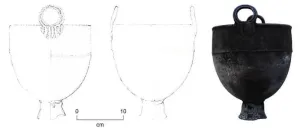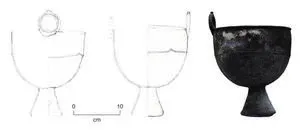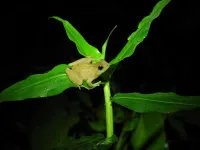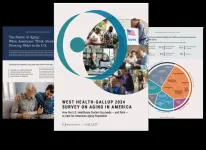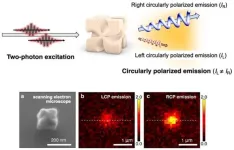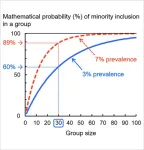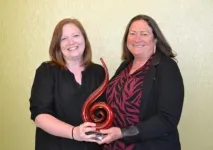(Press-News.org) Bronze cauldrons were used by the inhabitants of the Mongolian steppe around 2,700 years ago to process animal blood and milk. This is shown by a protein analysis of archaeological finds from this period.
Scattered across the Eurasian steppe, archaeologists repeatedly come across metal cauldrons from the Bronze Age during excavations. However, it was previously unclear exactly what they were used for. Now, an international study led by researchers at the University of Basel and published in the journal Scientific Reports reveals their secret: Mongolian nomads collected blood from slaughtered animals, presumably for sausage production, in these cauldrons and may have also fermented milk in them, mainly from yaks.
The research team led by Dr. Shevan Wilkin from the University of Basel carried out extensive protein analyses on two metal cauldrons that were discovered in 2019 by herders in northern Mongolia, along with other artifacts. According to radiocarbon dating, the cauldrons date back to the late Bronze Age, i.e. they were in use around 2,700 years ago.
Animal blood in the diet has a long tradition
In the cauldrons, the researchers identified blood remains from ruminants, mainly sheep and goats. “Various historical accounts of the steppe dwellers claim that they regularly drank blood,” explains Dr. Bryan Miller from the University of Michigan, USA, co-author of the study. The new findings now provide a clearer idea of how blood may have been incorporated into the diet of the steppe dwellers.
The researchers suspect that blood was collected in the cauldrons during slaughtering to make blood sausages – a practice similar to contemporary culinary customs in Mongolia. “These parallels with modern times, together with well-founded historical accounts of diet and slaughtering practices in the region, suggest that the processing of blood was a traditional part of Mongolia's food culture,” says study leader Shevan Wilkin. Sausage production was also an important preservation method for other steppe peoples.
Yaks domesticated earlier than thought
In addition to blood proteins, the cauldrons also contained traces of milk, particularly from domestic cattle and yaks. “This shows that yaks were domesticated and milked in Mongolia much earlier than previously assumed,” notes Wilkin. The milk might have been fermented in the cauldrons in order to preserve it in the form of yogurt, or it might have been an ingredient in the production of sausages.
“Our discoveries offer insights into the traditions and diet of Bronze Age nomads and shed light on the diverse culinary methods of ancient civilizations,” explains Wilkin. In addition to the Universities of Basel and Michigan, experts from the Max Planck Institute for Geoanthropology in Jena and the National Museum of Mongolia were also involved in the research project.
END
Blood sausages and yak milk: Bronze Age cuisine of Mongolian nomads unveiled
2024-06-05
ELSE PRESS RELEASES FROM THIS DATE:
Genetics study points to potential treatments for restless leg syndrome
2024-06-05
Scientists have discovered genetic clues to the cause of restless leg syndrome, a condition common among older adults. The discovery could help identify those individuals at greatest risk of the condition and point to potential ways to treat it.
Restless leg syndrome can cause an unpleasant crawling sensation in the legs and an overwhelming urge to move them. Some people experience the symptoms only occasionally, while others get symptoms every day. Symptoms are usually worse in the evening or at night-time and can severely impair sleep.
Despite the condition ...
Scientists detect slowest-spinning radio emitting neutron star ever recorded
2024-06-05
Scientists have detected what they believe to be a neutron star spinning at an unprecedentedly slow rate —slower than any of the more than 3,000 radio emitting neutron stars measured to date.
Neutron stars - the ultra-dense remains of a dead star - typically rotate at mind-bendingly fast speeds, taking just seconds or even a fraction of a second to fully spin on their axis.
However, the neutron star, newly discovered by an international team of astronomers, defies this rule, emitting radio signals on a comparatively ...
Tiny tropical puddle frogs show that protecting genetic variation is essential for animals to survive the climate crisis
2024-06-05
Even widespread species could be genomically vulnerable to the climate crisis, scientists warn. By studying the DNA of puddle frogs living in central African rainforests, the scientists found that areas of high environmental variation foster high genetic variation. If these varied habitats and the frogs that live there are lost, genetic variants that could have allowed the species to evolve to survive the climate crisis could be lost too. Meanwhile, populations with low genetic variation could become extinct quickly, unable to adapt.
“Generally, the more genomic variation within ...
3 in 4 Americans under 65 are worried about future of Medicare
2024-06-05
WASHINGTON, D.C. — June 5, 2024 — Concerns over the potential insolvency of Medicare among those under 65 have risen, with 73% now expressing worry that it won’t be available when they need it, up from 67% in 2022, according to the new West Health-Gallup 2024 Survey on Aging in America. Worry rose most amongst those aged 50 to 64, up 13 percentage points to 74%. Higher percentages of adult’s express concern about the future of Social Security, with 80% of people under 62 and 86% of people aged 40 to 49 fearing it will not be around once they are eligible.
According ...
Gold nanoparticles that selectively emit left-/right-handed light
2024-06-05
doi.org/10.1002/adom.202400699When chiral(1) gold nanoparticles(2) are irradiated with near-infrared(3) femtosecond pulses(4), visible emission of luminescence is observed. In this study, this luminescence was found to yield high selectivity for left- or right-handed circularly polarized(5) light, depending on the chirality of the nanoparticles, with a dissymmetry factor(6) of approximately 0.7. This finding suggests the potential to elevate various applications using circularly polarized light to practical levels.
Abstruct
The research group led by Project Assistant Professor Dr. Hyo-Yong AHN, ...
New AI algorithm detects rare epileptic seizures
2024-06-05
More than 3.4 million people in the US and 65 million people worldwide have epilepsy, a neurological disorder that affects the nervous system and causes seizures. One in 26 people will develop epilepsy at some point in their lives, and 1 out of 1000 people with epilepsy die from unexpected deaths each year.
Like many conditions, epilepsy treatment starts with early detection. The World Health Organization estimates that 70% of people with epilepsy could live seizure-free if adequately diagnosed and treated.
Over the years, ...
People underestimate the probability of including at least one minority member in a group
2024-06-05
Niigata, Japan - Human society includes various minority groups. However, it is often difficult to know whether someone is a minority member simply by looking at the person, as minority traits may not be visually apparent (e.g., sexual orientation, color vision deficiency). In addition, minorities may hide their minority traits or identities. Consequently, we may have been unaware of the presence of minorities in daily life. Probabilistic thinking is critical in such uncertain situations. The people with whom we interact in our daily lives are typically a group of several dozen individuals (e.g., a school class). How do we judge the probability of including at least one minority ...
Celebrate Pride Month by learning CPR. The life you save may be someone you love
2024-06-05
DALLAS, June 4, 2024 — According to the American Heart Association, when someone suffers a cardiac arrest, immediate cardiopulmonary resuscitation (CPR) is critical and can double or triple a person’s chance of survival. More than 350,000 out-of-hospital cardiac arrests occur in the United States each year. Of those, 90% will not survive, according to the Association, which is working to turn more bystanders into lifesavers who can use CPR in an emergency. The American Heart Association, celebrating one hundred years of lifesaving service as a global ...
Dr. Erin Belval honored for exemplary fire science research
2024-06-05
FORT COLLINS, Colo., June 4, 2024 — Dr. Erin Belval, a research forester at the USDA Forest Service Rocky Mountain Research Station, was awarded the Early Career Scientist Award in Fire Science from the International Association of Wildland Fire (IAWF). She received the honor last month at the 2024 International Wildland Fire Conference in Boise, Idaho.
The award recognizes promising early-career professionals who demonstrate outstanding ability in any field of wildland fire science. Belval was nominated by colleagues and peers for her outstanding contributions.
“The award is particularly meaningful because ...
A novel approach to tracking conservation reveals more areas may be conserved than currently accounted for
2024-06-05
(Santa Barbara, Calif.) — Thirty by thirty. It’s an ambitious answer to growing calls for protecting more of our planet’s surface. The goal is to conserve 30% of the Earth’s oceans, lands and freshwaters by 2030. While this may seem a lofty aim, the diversity and coverage of conservation areas today might be greater than what’s currently recognized by global tracking systems.
An international team of conservation researchers and practitioners, led by scientists at UC Santa Barbara and The Nature Conservancy, has developed an inclusive inventory approach for tracking ...
